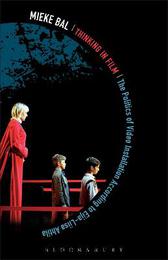
|
Thinking in Film: The Politics of Video Art Installation According to Eija-Liisa Ahtila
Paperback / softback
Main Details
Description
What is a moving image, and how does it move us? In Thinking In Film, celebrated theorist Mieke Bal engages in an exploration - part dialogue, part voyage - with the video installations of Finnish artist Eija-Liisa Ahtila to understand movement as artistic practice and as affect. Through fifteen years of Ahtila's practice, including such seminal works as The Annunciation, Where Is Where? and The House, Bal searches for the places where theoretical and artistic practices intersect, to create radical spaces in which genuinely democratic acts are performed. Bringing together different understandings of 'figure' from form to character, Bal examines the syntax of the exhibition and its ability to bring together installations, the work itself, the physical and ontological thresholds of the installation space and the use of narrative and genre. The double meaning of 'movement', in Bal's unique thought, catalyses anunderstanding of video installation work as inherently plural, heterogenous and possessed of revolutionary political potential. The video image as an art form illuminates the question of what an image is, and the installation binds viewers to their own interactions with the space. In this context Bal argues that the intersection between movement and space creates an openness to difference and doubt. By 'thinking in' art, we find ideas not illustrated by but actualized in artworks. Bal practices this theory in action to demonstrate how the video installation can move us to think beyond ordinary boundaries and venture into new spaces. There is no act more radical than figuring a vision of the 'other' as film allows artto do. Thinking In Film is Mieke Bal ather incisive, innovative best as she opens up the miraculous political potential of the condensed art of the moving image.
Author Biography
Mieke Bal is the author of Reading Rembrandt: Beyond the Word-Image Opposition, Narratology: Introduction to the Theory of Narrative, and many other books. She is Professor of the Theory of Literature at the University of Amsterdam, and has also been affiliated with Columbia University, the University of Rochester, and Cornell University, USA.
ReviewsThinking in Film sweeps aside disciplinary convention to uncover a whole new way of thinking about thought. Turning the form of the artist monograph inside out, Mieke Bal brilliantly derives from the work of Eija-Liisa Ahtila the most replete account yet of the process by which ideas are actualized in the medium of the moving image. * Professor Jill Bennett, founding director of the National Institute for Experimental Arts & Associate Dean of Research, COFA, University of New South Wales, Australia * Thinking in Film is the most compelling analysis of Eija-Liisa Ahtila's art to date. It is a contribution to thinking by extending the ideas of what is presentable, perceivable and thus knowable. Mieke Bal draws from the constitutive conceptual and theoretical underpinnings of audio-visual installation art and gallery film but, importantly, develops her thinking further through a close analysis of the artworks. Bal shows how viewers are affected by the audio-visual realm but also left space to exert their own agency. The book demonstrates how art matters as a critical practice that has wider socio-cultural and political relevance. * Mia Hannula, Art Historian and Scholar, University of Turku, Finland * The breadth and scale with which she builds her analysis is overwhelming. Rarely have I come across such a minute and sensuous reading of this art form. * Nalini Malani has been a pioneer in Indian video art since the early 1990s; her multi-layered theatrical installations are characterized by a distinctly poetic approach, and originate in narratives drawn from international zones of conflict. *
|